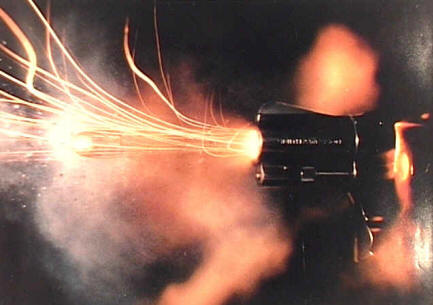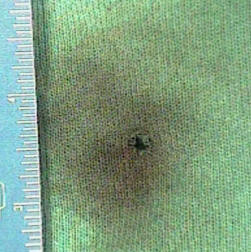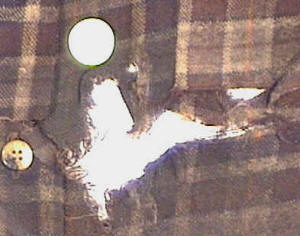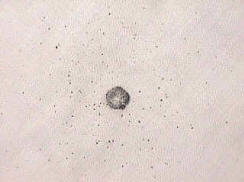Gunshot Residue
When
the firing pin of a firearm strikes the primer of a cartridge the primer
compound ignites sending a flame into the cartridge
case. Gunpowder in the cartridge case starts to
burn, causing it to change from a solid material to a gas.
This change creates pressure within the cartridge, which in turn
forces the bullet down the barrel and down range. Pressure
building behind the bullet is released when the bullet exits the
muzzle of the firearm.
The bullet acts like the
cork in a shook up Champagne bottle. When the bullet exits
the muzzle, pressure behind it blows the gunshot residues out of
the firearm's barrel under high velocity. The residues are
expelled from the barrel in a smoky cone shaped pattern.

Time-lapsed image showing a
bullet exiting from the barrel. Streaks of burning gunpowder,
smoke, and unburned
particulate can be seen exiting the barrel as well.
The further
gunshot residues travel from the muzzle, the broader
and less concentrated the pattern becomes. Because
the various elements included in gunshot residues are very small and lack
mass they lose their energy rapidly.
Gunshot
residues can also be emitted from other areas of a firearm. As you can
see in the above image, gunshot residue is escaping from the
barrel/cylinder gap of the revolver.
The muzzle-to-garment
distance can vary considerably depending on the firearm and type of
ammunition being used. Short-barreled firearms and lower
velocity cartridges will not normally expel residues as far as a
high velocity rifle. At shorter distances however, they
may deposit greater concentrations of gunshot residues.
Also, gunpowder can come in several forms such as ball, flake,
disc, and others. Ball powder being spherical in shape is
more aerodynamic than say a particle of flake gunpowder and as a
result will travel farther. A number of other variables
can influence the amount of gunshot residues that may reach a
target; therefore, it is essential that the firearm and
ammunition used in the shooting incident be recovered.
Gunshot
residues emitted from the muzzle will travel
out to distances of approximately 3 and 5 feet in most firearms but in
some cases
can travel even greater distances. At
the 3-5 foot range the gunshot residues may only consist of a
few trace particles and make determining the firing distance
difficult if not impossible.
As the firearm gets closer to
its target the residue concentrations increase and the actual
size or diameter to the pattern gets smaller. At around
18-24 inches most firearms will start to deposit considerable
concentrations of gunshot residues that may or may not be
visible to the eye.
At distances of less than
around 12 inches heavy concentrations of visible gunshot
residues will normally be deposited.

Visible gunshot residues
around bullet entrance hole.
When the muzzle of the
firearm gets next to or is in contact with the target, hot gases
escaping from the muzzle at high velocity will typically rip,
tear, shred, and/or melt the material of the target. A
very intense deposit of gunshot residues will be found around
the margins of a contact or near contact entrance hole.

Contact gunshot entrance
hole.
There have actually been cases where a hard contact gunshot (muzzle
pressed hard against the victim) caused the residues to blow through
the wound tract in the victim and be deposited around the inside of
the exit hole of the victim's clothing.
Gunshot residue is
normally a
combination of gunpowder residues and lead
residues. I say normally because some newer ammunition
is virtually lead-free. More and more ammunition
manufacturers are using lead free or low lead propellants
because of the toxicity of lead.
Gunpowder
residue can contain unburned gunpowder particles,
partially burned gunpowder particles or the carbonaceous soot from
completely burned gunpowder. The image below show a bullet
hole surrounded by gunpowder particulate residue.

Gunpowder particulate residue
around bullet entrance hole.
Modern
smokeless gunpowder, and black powder, contains nitrate
compounds. Black powder normally contains a combination of potassium
nitrate (75%), charcoal (15%), and sulfur
(10%). Smokeless powders can either be single based
or double based. Single based gunpowder will
contain nitrocellulose (cellulose hexanitrate) as its
main ingredient. Double based gunpowder contains nitrocellulose
and nitroglycerin (glyceral trinitrate) as its base.
Some triple-based powders are also now available.
When
either of these types of gunpowder burns the residue left behind will
be in the form of a nitrite-based compound.
Nitrite particles when emitted from the muzzle of a firearm will
strike a nearby target and either be imbedded in the target's
surface or leave a deposit of nitrite residue.
Lead
residues will be in a vaporous or particulate form and can
come from a couple sources within a
discharged cartridge. The most common source is the primer.
Primers are used to
start the ignition process in cartridges and commonly contain lead
styphnate, barium nitrate, and antimony sulfide compounds.
However, some newer primer compounds are being used that are
lead and/or barium free.
Cartridges
containing lead based primers, when ignited, produce a vaporous
cloud of residue that is expelled from the muzzle of the
firearm. Additional vaporous lead residues can be produced when
the hot gases pushing a lead bullet down a barrel melt lead from the
base of the bullet.
A third form of lead residue will be in a particulate
form. Particulate lead residue comes from minute lead particles
that are shaved from the sides of a lead bullet as it travels down the
barrel. Lead particulate has more mass than vaporous lead and
travels greater distances. Also, gunpowder particles can be
coated by the vaporous lead residues and leave what appears to be a
lead particulate deposit upon striking the target.
The
amount of lead residue emitted from a gun can vary slightly from shot
to shot. Fouling in the barrel from previous shots can slightly
increase the amount of lead residue emitted from one shot to the next.
As
described above, gunshot residue can be deposited on articles of
clothing when in close proximity to a discharged firearm. But
will it stay there? In most cases the answer is yes.
The various elements
contained in gunshot residue are not readily water soluble and
clothing left exposed to the elements will not usually diminish
the residue deposits. Other factors such as heavy bleeding
and rough handling of the garment can cover up or dislodge some
residues. This has to be taken into consideration when
conducting all such examinations. The garments must be
promptly collected, allowed to air dry, and packaged in a way
that will minimize contamination.
The clothing
submitted to the laboratory will be examined to determine if a
pattern of gunshot residue is present and there are a number of
examinations conducted to aid in this determination. Click next
below to learn more.
|